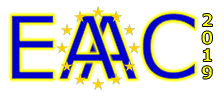Speaker
Description
Charged particle acceleration using solid-state nanostructures is attracting new attention in recent years as a method of achieving ultra-high acceleration gradients, in principle of up to ~1 TV/m [1]. The use of carbon nanotubes (CNT) has the potential to enable limitations of using natural crystals, e.g. in channeling aperture and thermo-mechanical robustness, to be overcome. In this work, we present an effective theory of the interaction of a relativistic particle beam with a single-walled CNT using a hydrodynamical model of conduction electrons in the CNT, with a view towards a description of electromagnetic (EM) fields in a CNT-array based accelerator. The model is compared to results from Particle-in-Cell simulations assuming similar beam parameters and conditions as at available facilities such as CLEAR at CERN and CLARA at Daresbury, UK. The roles of CNT wall-thickness, electronic properties, beam parameters, and CNT-array properties in the excitation of EM and plasmon modes are discussed.
[1] Y. M. Shin, D. A. Still, V. Shiltsev, Phys. Plasmas 20, 123106
(2013)

